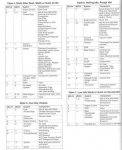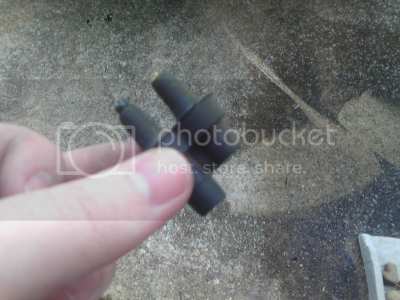yo Kyle, Have you checked for codes yet?
Try a Self Test for Diagnostic Trouble Codes (DTC)s by my pal, BroncoJoe19
http://broncozone.com/topic/14269-code-reader/page__pid__74587__mode__threaded
The engine temperature must be greater than 50° F for the Key On Engine Off (KOEO) Self-Test and greater than 180° F for the Key On Engine Running (KOER) Self-Test.
Run it around to heat the engine up and shift thru all gears incl Reverse. Then turn off all accessories/lights, etc.
Make sure A/C is off and transmission is in Park (automatic) or in Neutral for a Manual & release clutch.
Do Key On Engine Off (KOEO) portion first
And Post em here according to:
KOEO
&
KOER
===========
And this is by Charlie Probst; He wrote Ford Fuel Injection and Electronic Engine Control: How to Understand, Service and Modify, 1988-1993;
see table 6

the complete book is over 85MB pdf and can be downloaded @
http://www.yunost.ru/docs/Ford-injectors-book/Book.pdf
Scroll Down on First Page, Click on each Section, then on next page, click on the pdf file
Idle Air Control (IAC); also called, Idle Air Bypass (IAB), Idle Speed Control (ISC), Throttle Bypass Air, Idle Bypass, Inlet Air Controller, Inlet Air Bypass, Intake Air Bypass, Intake Air Control
try unplugging the IAC motor. If the idle drops, its usually due to an input signal to the computer which results in the computer raising the idle speed. If this is the case, look at all of the computer inputs to make sure everything is up to par. If the engine RPM does not drop when the IAC motor is disconnected, then either the IAC motor is not functioning properly, or, there is a vacuum leak in the engine. Stop the engine, remove the IAC motor and block off the passages. Restart the engine to see if there is any change in engine RPM. An idle speed higher than base idle specs indicates a vacuum leak. If the engine RPM is at base idle specs, then the IAC motor is bad. Resistance specs are 7-13 ohms. A good resistance reading does not necessarily mean that the IAC motor is good. Occasionally, an IAC motor will become weak, and will actually bypass too much air, causing a high idle condition even though everything else is operating properly.
Check for Vacuum Leaks; see my post @
http://broncozone.com/topic/22770-low-idle/
I know you wrote that you checked the lines, but check other places as well; Here is
Part of the test;
Vacuum Leak Test; On an idling engine check for vacuum leaks using a mechanic's stethoscope with the probe removed, or a ~3' garden hose section. BEWARE of fab, belts, pulleys and hot engine/hoses.
On COLD ENGINE only, use propane torch w/rubber hose attached, UNLIT (have fire ext @ hand for all tests)
or spray carb cleaner, when it gets to the the leak the RPMs will rise.
Also check: vacuum hoses; intake manifold gasket & throttle body and lower intake;
Vacuum Tree
PCV line
Air Diverter Valve (AIRD) from TAD Solenoid & Air Bypass Valve (AIR BPV) from TAB Solenoid or a Air Bypass Valve (AIR BPV) & Air Diverter Valve (AIRD) Combination located behind the intake manifold
vacuum reservoirs
AC, heater, defroster, vent control ckt & vacuum tank (plastic ball, or an irregular box glued to the evaporator cover), under dash & lines to heat/blend/etc. doors; & HVAC vacuum reservoir;
Carbon Canister (Charcoal Canister, Vapor Canister, Evaporative Emission (EVAP) Canister for the Evaporative System
Fuel Pressure Regulator (FPR)
and line to & Cruise Control sys in 86-91
leaky O-rings around the fuel injectors are allowing air to leak past the seals.
worn throttle shaft
& Line to & the power brake booster, Master Cylinder & Booster








